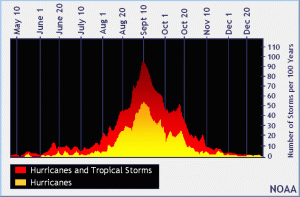Aug
20

Posted by Sarah Levin-Lederer on August 20th, 2021
Posted in: Blog
Tags: Emergency Preparedness (EPP), resources

From NOAA: The official hurricane season for the Atlantic Basin is 1 June to 30 November. As seen in the graph above, the peak of the season is from mid-August to late October.
It’s that time of year again. Hurricane season in the Atlantic Basin (Atlantic Ocean, Caribbean Sea and Gulf of Mexico) is from June 1 to November 30 and peaks in mid-August to late October.
Here in the Northeast, hurricanes may not be the first thing we think of when we think about preparing for an emergency. But we’ve seen a far share from Hurricane Irene in 2011 that caused 16 deaths in New England to Hurricane Sandy in 2012 that caused significant damage in New York to Hurricane Isaias in 2020 that caused extensive power outages, and even Tropical Storm Elsa already in 2021.
Climate change is predicted to lead to more and bigger storms that will pose significant issues to costal states including increased flooding and costal erosion in Rhode Island, Massachusetts, New Hampshire and New York. This increase in storm activity makes it even more important for us to learn about hurricanes and how to prepare.
Prepare (before)-Get ready before a hurricane with these tips from ready.gov and the American Read Cross.
Response (during)-Know what to do if you need to evacuate or shelter in place and learn about hurricane sheltering and COVID-19 with information from CDC.
Follow trusted sources on social media to avoid scams and hoaxes and stay up-to-date since weather conditions can change quickly during an emergency. On twitter, follow @nnlm_region7, @fema, @femaregion1 (New England), @femaregion2 (New York), @nws, local news outlets, and local and state government accounts.
Recovery (after)-Help yourself and your community recover with resources from ready.gov.
Natural disasters are stressful. If you need help after experiencing a natural disaster or other emergency, you can call or text the SAMHSA disaster distress helpline at 1-800-985-5990 with services available in English, Spanish and ASL.